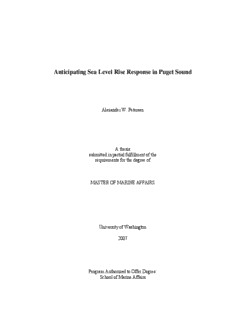
Anticipating Sea Level Rise Response in Puget Sound - Center for PDF
Preview Anticipating Sea Level Rise Response in Puget Sound - Center for
Anticipating Sea Level Rise Response in Puget Sound Alexander W. Petersen A thesis submitted in partial fulfillment of the requirements for the degree of MASTER OF MARINE AFFAIRS University of Washington 2007 Program Authorized to Offer Degree: School of Marine Affairs University of Washington Graduate School This is to certify that I have examined this copy of a master’s thesis by Alexander W. Petersen and have found that it is complete and satisfactory in all respects, and that any and all revisions required by the final examining committee have been made. Committee Members: ______________________________________________________ Edward L. Miles ______________________________________________________ Thomas M. Leschine ______________________________________________________ Douglas J. Canning Date: ___________________ In presenting this thesis in partial fulfillment of the requirements for a master’s degree at the University of Washington, I agree that the Library shall make its copies freely available for inspection. I further agree that extensive copying of this thesis is allowable only for scholarly purposes, consistent with “fair use” as prescribed in the U.S. Copyright Law. Any other reproduction for any purposes or by any means shall not be allowed without my written permission. Signature______________________________ Date _________________________________ University of Washington Abstract Anticipating Sea Level Rise Response in Puget Sound Alexander W. Petersen Chair of the Supervisory Committee: Professor Edward L. Miles School of Marine Affairs When faced with the issues of climate change and sea level rise, decision-makers are unable to wait for scientific uncertainties to be resolved before taking action. Sea level rise predictions are complicated by the complex non-linear nature of the climate system and long-term dependence on human choices. This study analyzes the regulatory and institutional structure surrounding coastal zone management in Puget Sound, Washington, in order to identify barriers to and opportunities for sea level rise response. Viewing the problem from a resilience perspective proves valuable as it builds off the social-ecological system concept, embraces change, and attempts to find ways to co-exist with uncertainty. The selection of non-catastrophic sea level rise scenarios and the creation of a variety of high-resolution, location specific, inundation maps are used to identify areas of vulnerability. Focusing on local government, four potential sea level rise response options are identified along with associated barriers. 1) Increase the update frequency for floodplain maps to more accurately reflect environmental changes. 2) Include consideration of a dynamic shoreline when making shoreline armoring, cumulative impacts, and no net loss of ecological function determinations. 3) Use shoreline designations in the Shoreline Management Act to tailor responses to the coastal environment. 4) Leverage the Federal Consistency and funding provisions of the Coastal Zone Management Act to enhance response options. The long-term nature of the sea level rise issue provides response opportunities not available in other arenas. By using the tools currently available, local decision-makers can limit the response costs and create a more robust policy framework capable of incorporating uncertainty and adapting to sea level rise. Table of Contents Page List of Figures....................................................................................................................iii List of Tables.....................................................................................................................iv Glossary..............................................................................................................................v 1.0 Introduction..................................................................................................................1 2.0 Focus of the Study........................................................................................................3 2.1 Research Questions...................................................................................................3 2.2 Scope of Study..........................................................................................................3 2.3 Mitigation vs. Adaptation.........................................................................................4 2.4 Public Institutions.....................................................................................................5 3.0 Methodology.................................................................................................................6 3.1 Major Components....................................................................................................6 3.2 Scenario Development..............................................................................................6 3.3 Generalizing this Approach......................................................................................7 4.0 Climate Change and Sea Level Rise Science...............................................................8 4.1 The Global Climate System......................................................................................8 4.2 Sea Level Rise...........................................................................................................8 4.3 Global Sea Level Rise Predictions............................................................................9 4.4 Regional Scale Sea Level Rise Predictions............................................................10 4.5 Sea Level Rise Uncertainty.....................................................................................11 5.0 Resilience Framework................................................................................................13 5.1 Resilience Theory...................................................................................................13 5.2 Fast and Slow Variables..........................................................................................14 5.3 Non-linear Response...............................................................................................15 5.4 Thresholds...............................................................................................................16 5.5 Exposure, Sensitivity, and Adaptive Capacity........................................................16 6.0 Application of Resilience to Sea Level Rise...............................................................19 6.1 Focusing on Resilience...........................................................................................19 6.2 Fast and Slow Variables..........................................................................................20 7.0 Puget Sound Sea Level Rise Scenarios.......................................................................22 7.1 Areas Mapped.........................................................................................................22 7.2 Mapping Methodology............................................................................................23 7.2.1 Vertical Land Movements................................................................................24 7.2.2 Horizontal and Vertical Accuracy...................................................................24 7.3 Inundation Scenarios...............................................................................................25 7.4 Scenarios and Increased Learning..........................................................................26 i 7.5 Sea Level Rise Inundation Maps............................................................................28 7.6 Floodplain Mapping................................................................................................33 8.0 Legal and Institutional Structure.................................................................................37 8.1 Existing Framework................................................................................................37 8.1.1 Key Legal & Regulatory Components.............................................................37 8.1.2 Previous Work.................................................................................................39 8.2 Summary of Key Opportunities..............................................................................40 8.3 Flooding..................................................................................................................41 8.3.1 Technical Issues...............................................................................................41 8.3.2 Institutional Framework...................................................................................43 8.3.3 Larger Scale Issues..........................................................................................43 8.3.4 Regulatory Structure........................................................................................44 8.3.5 Potential Response Options.............................................................................45 8.4 Shoreline Armoring, Cumulative Impacts, and “No Net Loss”..............................46 8.4.1 Technical Issues...............................................................................................47 8.4.2 Institutional Structure.......................................................................................48 8.4.3 Larger Scale Issues..........................................................................................49 8.4.4 Regulatory Structure........................................................................................50 8.4.5 Potential Response Options.............................................................................51 8.5 Shoreline Management Act: Shoreline Designations.............................................52 8.5.1 Regulatory Structure........................................................................................52 8.5.2 Potential Response Options.............................................................................53 8.6 Coastal Zone Management Act...............................................................................54 8.6.1 Institutional Framework...................................................................................54 8.6.2 Regulatory Structure........................................................................................55 8.6.3 Cross-scale Issues............................................................................................55 8.6.4 Potential Response Options.............................................................................56 9.0 Conclusion..................................................................................................................58 List of References.............................................................................................................64 Appendix A: Mapping Methodology................................................................................72 ii List of Figures Figure Number Page Figure 1: Resilience landscape..........................................................................................14 Figure 2: Sea level rise map locations..............................................................................22 Figure 3: Harbor Island inundation map...........................................................................28 Figure 4: Quartermaster Harbor inundation scenarios......................................................30 Figure 5: Olympia inundation scenarios...........................................................................32 Figure 6: Harbor Island floodplain changes......................................................................35 Figure 7: Washington State coastal laws and regulations.................................................38 iii
Description: